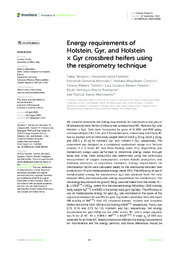Energy requirements of Holstein, Gyr, and Holstein x Gyr crossbred heifers using the respirometry technique.
Energy requirements of Holstein, Gyr, and Holstein x Gyr crossbred heifers using the respirometry technique.
Author(s): SILVESTRE, T.; FERREIRA, A. L.; MACHADO, F. S.; CAMPOS, M. M.; TOMICH, T. R.; PEREIRA, L. G. R.; RODRIGUES, P. H. M.; MARCONDES, M. I.
Summary: We aimed to determine the energy requirements for maintenance and gain of 18 prepubertal dairy heifers of three breed compositions (BC; Holstein, Gyr, and Holstein × Gyr). Diets were formulated for gains of 0, 400, and 800 g/day, corresponding to 1.0×, 1.5×, and 2.0× maintenance, respectively. Each dairy BC had six animals with an initial body weight (iBW) of 219.8 ± 32 kg, 215.8 ± 33 kg, and 228.3 ± 33 kg for Holstein, Gyr, and Holstein × Gyr, respectively. The experiment was designed as a completely randomized design in a factorial scheme 3 × 3 [three BC and three feeding levels (FL)]. Digestibility and metabolism assays were performed to determine energy losses through feces and urine. Heat production was determined using the continuous measurement of oxygen consumption, carbon dioxide production, and methane emissions in respiration chambers. Energy requirements for maintenance (NEm) were calculated based on the relationship between heat production (HP) and metabolizable energy intake (MEI). The efficiency of use of metabolizable energy for maintenance (km) was obtained from the ratio between NEm and metabolizable energy requirements for maintenance. The net energy requirements for growth (NEg) were estimated from the model RE = β0 × EBW0.75 × EBGβ1, where RE is the retained energy (Mcal/day), EBW is empty body weight (kg0.75), and EBG is the empty body gain (kg/day). The efficiency of use of metabolizable energy for gain (kg) was estimated as the slope of the regression between RE and MEI for gain. Gyr heifers presented NEm 15% lower (98 kcal/kg of BW0.75) than HG crossbred animals. Holstein and crossbred heifers had similar NEm, 102 and 112 kcal/kg of BW0.75, respectively. The km was 0.71, 0.74, and 0.75 for HG, Holstein, and Gyr, respectively. Net energy requirement for gain (NEg) did not differ across BC, and a single equation was fit for all BC: RE = 0.069 × BW0.75 × BGW0.852. A single kg of 0.65 was observed for all three BC. Breed composition affected the energy requirements for maintenance and the energy partition, and those differences should be considered when estimating requirements for Gyr, Holstein × Gyr crossbred, and Holstein heifers.
Publication year: 2022
Types of publication: Journal article
Unit: Embrapa Dairy Cattle
Observation
Some of Embrapa's publications are published as ePub files. To read them, use or download one of the following free software options to your computer or mobile device. Android: Google Play Books; IOS: iBooks; Windows and Linux: Calibre.
Access other publications
Access the Agricultural Research Database (BDPA) to consult Embrapa's full library collection and records.
Visit Embrapa Bookstore to purchase books and other publications sold by Embrapa.

